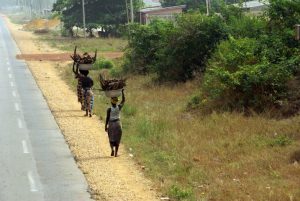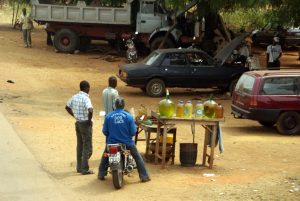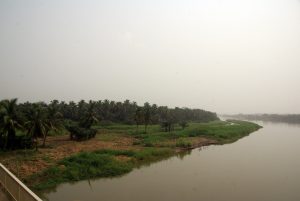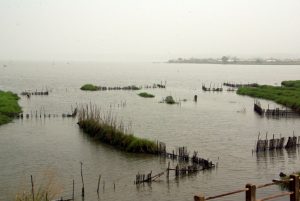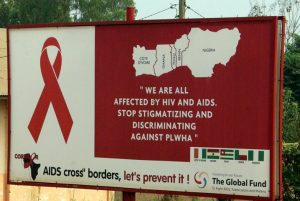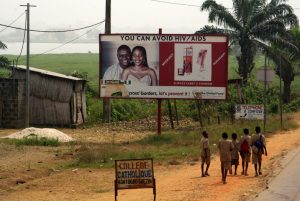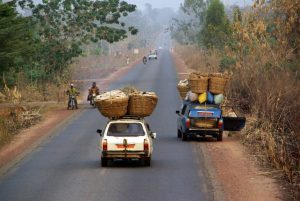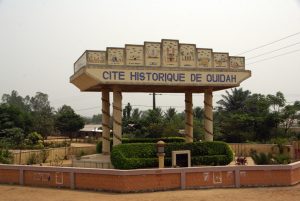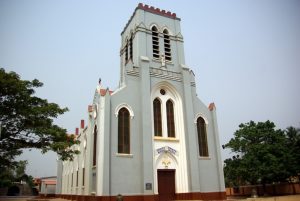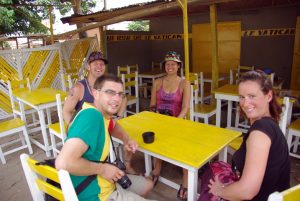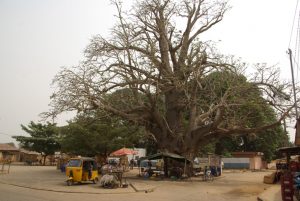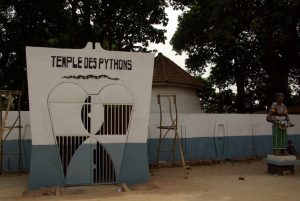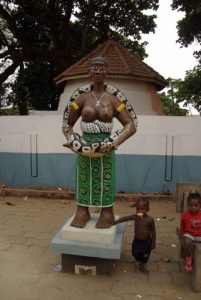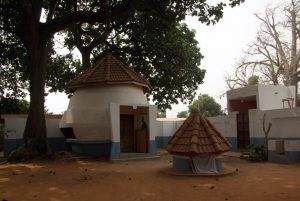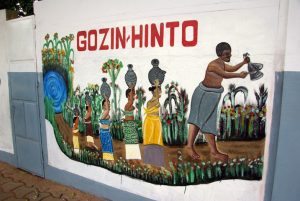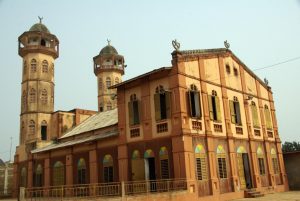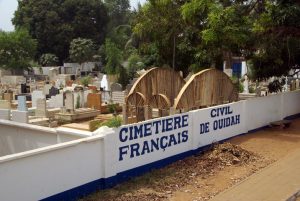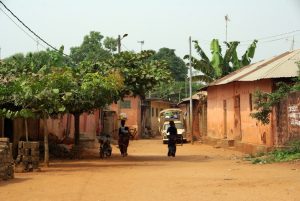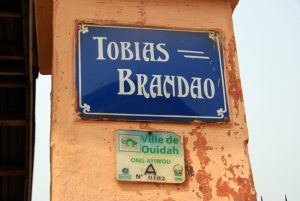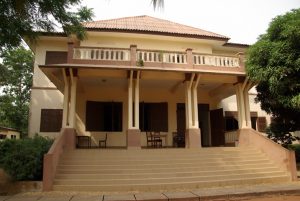Compact Benin was an unexpected highlight of our west Africa itinerary. We crossed the border from Togo to Benin via the border town of Hilakondji, and immediately headed towards Ouidah, a former slave town and now a center of voodoo. Here, we visited several museums, the Maison du Bresil which served as the Brazilian governor’s mansion, and the Museum of History, housed in the circa 1721 Portuguese fort of Sao Joao Batista. We also retraced the last 4 km walk of the slaves on the “Route des Esclaves”, which lead down to the coast and the Door of No Return. The next day, we visited Africa’s largest lake village, an extraordinary stilt village housing 40,000 inhabitants at Ganvie. While touristy, it was a highlight of Benin and not to be missed.
![]()
Women carrying bundles of firewood for the home
![]()
A motorcyclist stops to buy cheap roadside petroleum (entrepreneurial Béninois buy cheap fuel from neighboring Nigeria and smuggle it across the border to earn a bit of extra income)
![]()
Fish nurseries on the outskirts of Ouidah
![]()
An educational poster showing that AIDS can easily cross borders within west Africa
![]()
School children walk beneath an AIDS prevention poster
![]()
This gives a new meaning to the word "overload"; along the road to Ouidah
![]()
Entrance arch to the city of Ouidah
![]()
Ouidah Basilica sits just across the road from the Python Temple
![]()
Lucky, Dowelly, Becky & Bree sitting down for a drink at the Le Vatican Bar; Ouidah
![]()
Center of Ouidah (in front of the python temple)
![]()
Side entrance way to the Temple Des Pythons; Ouidah
![]()
Statue outside the python temple; Ouidah
![]()
Interior courtyard of Ouidah's python temple, where the sleepy snakes were locked away for their mid afternoon siesta
![]()
Wall mural outside the Python Temple which is the home for Ouidah's snake cult
![]()
French cemetery in the city of Ouidah
![]()
We explored Ouidah on foot and really liked the ambience and feel of this former slave city
![]()
The Afro-Brazilian building that served at the Brazilian governor's residence in Ouidah; currently houses the "Women in Africa" exhibit
![]()
The quintessential image of an African woman carrying a basket on top her head; Women in Africa exhibit at the Maison du Bresil in Ouidah
![]()
Sculpture on display at the Women in Africa exhibit; Ouidah's Maison du Bresil
![]()
A patchwork quilt showing an African wife being kicked out of her home when her husband takes on a new wife; Women in Africa exhibit at the Maison du Bresil
![]()
Opening display for the women of Africa exhibition; Maison du Bresil
![]()
Interesting sun-dial depicting an African woman's work day at the Maison du Bresil; Ouidah
![]()
Hear no evil, see on evil, speak no evil, carved into a tree trunk; Ouidah
![]()
Intricate carvings covered a large tree stump at a major intersection of Ouidah
![]()
Lucky seems to really like the nicely carved tree stump just behind him in Ouidah
![]()
Dowelly, Lucky, Robby and Bree pose on Avenue de France in Ouidah
![]()
Handmade items for sale along the streets of Ouidah
![]()
Crumbling ruins of an Ouidah dwelling
![]()
Dowelly, Becky & Lucky at the entrance to Portuguese Fort Sao Joao Batista
![]()
Portuguese Fort/Museum Sao Joao Batista; Ouidah
![]()
Canon view at the circa 1721 Portuguese fort of Sao Joao Batista in Ouidah
![]()
Horse carriage on display at Ouidah's Museum of History (housed in the Portuguese Fort of Sao Joao Batista)
![]()
A patch work quilt of the diverse African continent
![]()
Courtyard view of Sao Joao Batista Fort; Ouidah
![]()
The Portuguese flag flew over this fort from 1721 until 1960 at the Sao Joao Batista Fort in Ouidah (now the Museum of History)
![]()
Crumbling colonial architecture is easy to stumble upon in Ouidah
![]()
Snapshot of a rustic scene in Ouidah
![]()
Royal emblems of the Chiefs of Abomey line the entire 4 km path of "Route des Esclaves" in Ouidah
![]()
Another Abomey statue on the "Route des Esclaves"
![]()
Kids stopping for a silly photo in Ouidah
![]()
Young boy sits on the base of one of the statues along the Route des Esclaves; Ouidah
![]()
Monuments line the entire "Route of Slaves", a 4 km path leading from the center of Ouidah down to the coast
![]()
A lady struggles to carry a heavy burden; Route des Esclaves
![]()
The 4 km slave walk in Ouidah is a must-do. There are numerous monuments and memorials along the way so it makes for an easy Ouidah excursion
![]()
Memorial to the slaves brought to Haiti from Ouidah; Route des Esclaves
![]()
Robby mimics an Abomey statue's pose; Route des Esclaves
![]()
These pigmy goats were head butting one another but took a brief pause to pose for a photo; Ouidah
![]()
A 3-headed Abomey Statue; Route des Esclaves in Ouidah
![]()
A friendly local man stops his motorcycle to pose for a photo and then continues on his way; Ouidah
![]()
One of many statues erected along the Route des Esclaves; Ouidah
![]()
Herding the cows home; Ouidah
![]()
Fishing village in the marshy backwaters along the Route des Esclaves; Ouidah
![]()
Young boys carrying bundles of leaves; Ouidah
![]()
Carved wooden crafts for sale outside the Door of No Return monument; Ouidah
![]()
The "Door of No Return" has earned UNESCO world heritage status and is a highlight of any Ouidah visit
![]()
Colorful figurine at the Door of No Return monument; Ouidah
![]()
Door of No Return monument; Ouidah
![]()
Shackled male and female slave depictions on the archway of the "Door of No Return"
![]()
"Door of No Return" monument; Ouidah
![]()
Artwork depicting a typical scene of women carrying a load on their head and a baby strapped to their back
![]()
Strong waves crashing against the beach near the Door of No Return monument; Ouidah
![]()
Dusk approaches the coastline near the former slave town of Ouidah
![]()
New road being constructed near Ouidah
![]()
Ouidah school kids returning from school
![]()
It is funny to be a tourist and have the local people taking photos of you
![]()
Impressive church near Ouidah
![]()
School children walking home for lunch
![]()
Taxis waiting for customers at a village market near Ouidah
![]()
Fisherman wades through the shallow river at a village near Ouidah
![]()
Fishermen hoping to catch that night's dinner; Ouidah
![]()
Any destination you want is straight ahead
![]()
Busy road linking Ouidah to Ganvie Lake Village
![]()
Signpost for the stilt village of Ganvie
![]()
Ladies setting up a fish market at the entrance to Ganvie Lake Village
![]()
Piles of cut branches to be used for fish traps at Ganvie Lake Village
![]()
Tourists who wish to visit the stilt village of Ganvie have two options of transport, a motorized or a traditional pirogue
![]()
Locals wishing to reach Ganvie village must endure an hour long pirogue ride to reach their destination (needless to say, the locals have extremely muscular arms from all the rowing!)
![]()
A traditional pirogue plying the waterways leading to Ganvie
![]()
Makeshift sails of a myriad of shapes, colors and sizes were seen on the Ganvie village pirogues
![]()
A fisherman steadies himself to throw his fishing net while balancing on his pirogue; Ganvie
![]()
Ganvie stilt village is home to 40,000 inhabitants who rely primarily on fishing for survival
![]()
The lakeside village of Ganvie is a thriving community complete with schools, hospitals, hotels and restaurants to support its inhabitants as well as tourists
![]()
Shopping in Ganvie is conducted by pirogue, and the vendors hustle around trying to make a sale
![]()
Hundreds of pirogues such as this one are filled to the brink with produce or merchandise, as the owners paddle from section to section in Ganvie attempting to lure potential customers
![]()
A teenaged girl prepares to throw her fishing net
![]()
We had been forewarned that Ganvie Stilt Village was "over touristy" but found it to be a proper, thriving community that isn't over-reliant on tourism
![]()
Ganvie residents navigating their way around their lakeside home
![]()
Ganvie residents become experts at handling their pirogues as it is their primary means of transportation in and around their village
![]()
A pirogue passes by a leaning stilt house; Ganvie
![]()
Detail of village life in Ganvie
![]()
A classic shot of a Ganvie resident navigating her way through the village
![]()
A massive statue dominates a construction site in Ganvie
![]()
Vendors discuss each other's wares for sale in an attempt to conduct business
![]()
View of Ganvie's floating market
![]()
Coca Cola has infiltrated Ganvie village!
![]()
Children have to take pirogues to get to school in Ganvie
![]()
These dug-out canoes (pirogues) are the only mode of transport for everything that goes in and out of Ganvie Lake Village
![]()
Nearly overloaded with firewood; Ganvie Lake Village
![]()
The purple water lilies growing just beneath the stilt homes in Ganvie make for a picturesque image
![]()
Tourist craft shops with great hand made items for sale; Ganvie Lake Village
![]()
Hand carved wooden pirogues for sale at a craft shop; Ganvie Lake Village
![]()
There may be room for one more without sinking; Ganvie Lake Village
![]()
A hotel, bar, restaurant and arts/crafts store all in one; Ganvie Lake Village
![]()
Taking hand woven baskets to sell at the floating market; Ganvie Lake Village
![]()
Shirts are optional for women in this region; Ganvie Lake Village
![]()
Give me a gift please; Ganvie lake Village
![]()
Locals making their way to the floating market to stock up on goods; Ganvie Lake Village
![]()
Ganvie resident getting ready for the long paddle home
![]()
With a precarious load, these ladies slowly paddle their pirogue back to Ganvie Village
![]()
A lady setting fishing traps at Ganvie Lake Village
![]()
A lady checks her fish traps with a baby strapped to her back
![]()
Some of the boaters were crafty and used the wind to their advantage; Ganvie Lake Village
![]()
In the western world, you would never see kids this young navigating a boat all on their own, but here in Benin, it is the norm
![]()
Young boys checking their fishing net; Ganvie Lake Village
![]()
Ladies chatting it up while taking a rest from paddling their pirogues
![]()
Ladies crowding up to sell their goods at the Ganvie floating market
![]()
Statue depicting both sexes at a craft shopping area; Ganvie Lake Village
![]()
Floating market vendors; Ganvie Lake Village
![]()
Colorful stilt houses; Ganvie Lake Village
![]()
Empty pirogues near the market at the entrance to Ganvie Lake Village
![]()
Market day near Ganvie Stilt Village
![]()
The fish market was busy when we returned from the Ganvie Lake Village tour
![]()
Freshly milled flour for sale by the roadside near Ganvie Lake Village
![]()
Lady selling chickens on the roadside near Ganvie Lake Village
![]()
Local boys walking home from school are amused by our big yellow truck; near Ganvie Lake Village
![]()
Pineapples were our fruit of choice in Benin
![]()
Anyone want bananas or papaya while waiting in the traffic jam?
![]()
Village mosque; Benin countryside
![]()
Excited Béninois school kids race out of school to wave hello
![]()
Village women walking by the roadside
20 Jan: We drove until the border crossing at Hilakondji, Benin around noon. Just across the border we stopped for about 10 minutes so anyone interested could grab street meat. Robby picked up some roasted pork for 2000 CFA. Though the meat was tasty the small amount we got ended up being a little bit expensive. Several other people got cold chicken for about 500 CFA each. While it was cheaper, it was not as tasty as the roasted pork. We stopped in Ouidah around 2 pm for lunch at an empty lot on Rue Van Vollenhoven. Lunch was veggie sandwiches but we didn’t eat much because we had the roasted pork a couple of hours earlier. After lunch we were joined by Bree, Lucky & Dowelly to head towards the Python Temple. While making our way there, we saw the rest of our group taking a different route, arriving to the temple just ahead of us. Just to keep from being all crowded in together, we opted to let them explore the temple first, while we took photos of the Ouidah Basilica and had drinks just across the street at the Vatican Café. Large local beer was a bargain at only 500 CFA. After our drinks, some of the others came from the Python Temple and said they were able to sneak a peek without paying or taking photos, but from what they could see, it was a tourist trap to be avoided. We walked over to check it out for ourselves but the entire temple complex appeared abandoned, so we quickly moved on. Our next destination was past the Ouidah Mosque down towards the Maison du Bresil (Brazilian Governor’s Mansion) but it seemed that we had walked further than 200 meters indicated on the map. After stopping and asking locals they pointed just a bit further down the street. Entry was 1000 CFA. The building was nothing extraordinary but it did have an interesting display of art and information related to Women in Africa. Then the attendant walked us next door to the exhibition of contemporary art & voodoo symbols. He attempted to charge us another 1000 CFA each. Lucky and Bree paid but the rest of us were not that interested. Seeing that he was pushing the limit on entry fees, he then allowed us all to visit with only the 2000 CFA collected from Lucky and Bree. The displays here were also interesting and gave a little insight into Voodoo beliefs. Additionally, there was a grave in the center of the building, which the attendant said was the resting place of an American voodoo leader. Afterwards, we headed back into Ouidah, and saw an intricately carved tree stump in a town square. It was pretty cool and we took quite a few photos of it from various angles, before heading onward to the Portuguese Fort Sao Joao Batista/Museum of History which was built in 1721. Entry was 1000 CFA and interesting enough to visit for its displays and views of the fort itself. From the fort we started our journey along the 4 km Route des Esclaves, which is the sandy route that slaves were forced to embark to begin their final trek from the center of town out to the beach and the Door of No Return. Interspersed at various locations along the track were green statues of various royal emblems of the Chiefs of Abomey, and we took several photos of the more interesting statues. The Door of No Return was well worth a visit, decorated with bas-relief images of male and female slaves on a large arch and sculptures of slaves in shackles. We paused and reflected on just how many slaves passed through this area to meet their fate in the Americas and the Caribbean and it was a very somber experience. Our campsite was the “Le Jardin Bresilien”, which would have earned rave reviews except that they charged a whopping 2000 CFA for the privilege of swimming in their pool. Instead, some of the braver boys decided to check out the tumultuous ocean for a free dip but they came back stating the water had a strong current and felt a bit too dangerous for their liking. After setting up our tent and downing an entire carton of mixed fruit juices to replenish our fluids, we hung our slightly damp sleeping gear on the laundry line to dry and enjoyed the vegetarian curry dinner that Bree, Luke and Kendra made for dinner tonight. Since time had shifted ahead by an hour when we crossed into Benin, everyone was in their tents shortly after dinner, making for another early night.
21 Jan: Breakfast consisted of scrambled eggs (thanks cook group) and we added nutella to our peanut butter toast for a nice change. We were on the road by 8 am headed to the Ganvie stilt village, which was listed as a highlight of Benin, albeit a touristy one. Since everyone on our group wanted to do the motorboat ride and there were 20 of us, the price came out to 3000 CFA each, and Nancy paid for the obligatory guide out of the group kitty. The morning started off hazy, making for some neat photos. To reach our motorized pirogue, we had to walk through the already bustling fish market and our group had to split up into two boats as we couldn’t all fit onto one vessel. According to our Rough Guide to West Africa guidebook, the Ganvie stilt village originated back in the days of the active slave trade, when the ancestors of the Tofinu people settled in the Lake Nokoué which was an ideal spot for grazing and farming. The slave traders, Dan-Homey, were forbidden for religious regions to extend their attacks over water, hence the name of the resulting village (Ganvie) derived its name from the Tofinu words “gan” (we are saved) and “vié” (community). Currently, 40000 residents call Ganvie home, and we found the lake full of fisherman casting their nets, and locals patiently rowing their pirogues towards the village. Our guide books and recommendations from previous travelers said it was really touristy and possibly worth skipping, but we found it well worth the visit. There were lots of photo opportunities and it was nice to just go for a boat ride. After the stilt village visit the next two cook groups (Robby, Hoff & Dowelly tonight) had to do shopping at the local market. Nancy pointed us towards the market and said there was a butcher area just past the market. The cook groups walked to the butcher area but it was closed and the locals said we had to take a taxi to the next closest one. Tonight’s cook group opted for a veggie dinner, buying 2 crates of eggs, green beans, cabbage, egg plant, green peppers, pineapple, onions and carrots. After shopping, Dowelly wanted to spend the last of his CFA coins so he bought a bunch of the Fandango (mango flavored Fan Ice). No one had tried it yet and we all found it to be one of the best they have to offer. We drove through several picturesque villages and were able to get some nice photos from the truck of local people, markets, and overloaded vehicles. We even saw a cargo truck that had swerved and flipped in the ditch. Locals were on the scene moving the goods into another truck to get everything to its destination. Around 1800 Chris scoped out a campsite just up a dirt road from what looks like a UNICEF humanitarian aid project. There was a whole small village of UNICEF tents set up and we even had a few local visitors walk over to our campsite just to say hello. Dinner was sweet veggie fried rice which turned out quite nice for a veggie meal. Bugs were swarming all around the lights so everyone jetted to their tents immediately after dinner. Luke and Mike were the last 2 after their chess game which ended at 2030.

